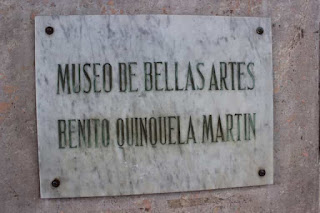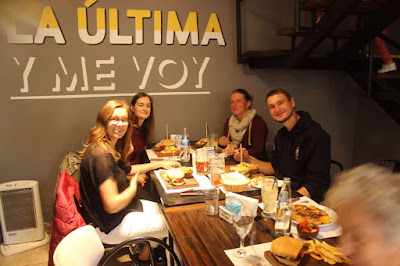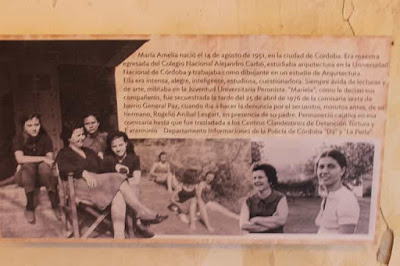While we were with Belen, Carolina had moved the car so it was close to the museum and we then went off to San Telmo market. Again, we were dropped off and with Caroline walked the open market, saw the church, and bought some home made soap.
And across the street was a very spiffy looking apartment building.
We went in to look at the church.
You can learn more about San Telmo - who was born in 1175 and was the patron saint of fishers and sailers in the south of Italy at the church website.
I got fascinated by the floor tiles. They have this Escher like patterN, and then in a spot of light, I saw that it was made up of pentagonal tiles. I want these in my house somewhere.
J liked the tiles out in front of the church.
Here’s the street market from in front of the church.
We got to what looked like a larger square that was filled with booths that looked more like a flea market and then up another street passing musicians, a magician, until we got to the San Telmo market. It was teaming with people. It’s a regular neighborhood market shops selling all sorts of things - fruits, vegetables - beautiful fresh vegies - meat. And lots of little places to eat.
On the right, they’re making empanadas.
We got a couple of vegetarian empanadas - the best I’ve ever had - and a humita chala, which was a mix of corn and onions and something else wrapped in a corn husk. I am going to have to figure out how they made that because it was delicious.
I found a Youtube of someone preparing humita chala. This is not an Argentine version because she adds some spicy sauce at the end, but it’s close enough for now.
We wandered around a bit more. At one point a car was trying to figure out where it wanted to go and the car behind it almost touched it and honked. Hands flew out the windows of the first car. I was in sympathy with them. They pulled into a parking place, but someone called out from a window to say they couldnt. But Belen told them we were just up the street and leaving so they followed us and all was well.
From there we wandered over to ‘the most expensive part of town”. Puerto Madero. It’s on an island and there are only a couple of bridges there. Lots of fancy high rise business and residential buildings.
We stopped and Belen wanted to show us the very fancy Faena Hotel, in a refurbished old brick building. We didn’t see much, but this long red space was striking. There’s a lot of money involved here. Belen asked for information on a tango show they have. “It’s not ‘a’ tango show, it’s ‘the best tango show” was the response. It’s $250 a person. I asked if that was pesos or dollars. Dollars. Is Lady Gaga in it? Belen smiled.
Then we got caught in a traffic jam. Nothing was moving. Well, sometimes the bridges are pulled up to let boats pass. In 15 minutes we were off the island and headed by the Colon National Theater and then by the old Synagogue.
We went through Recoleta - below is the church by the cemetery - and then back to where we are staying.
It was a gorgeous sunny day, in the upper 60s. But it got chilly in the late afternoon.
We got to talking about how they are building up this business. It’s hard. But they both know Buenos Aires well and are warm and helping people. They seemed to be having as good a time as we were. It was like good friends were showing us around. They are willing to just give people basic advice - how to get into town from the airport and find a good place to stay and get a bus pass - to actually arranging everything for people including taking them around to see things. Carolina also has special connections into some fields like polo.
i don’t usually make recommendations like this, but if anyone is going to Argentina and wants some help planning their trip, their website is Choice Buenos Aires. As I said in the previous post, it’s a work in progress. These women are much better at guiding tours and planning trips than making their website just the way they’d like it. And they also have a Facebook page and a Twitter page. (@aireschoice)
We had a really wonderful day yesterday. And tomorrow morning early, we head for the airport and our plane back to the US. I’m not ready to go back, even though we’ve been here a month.























































